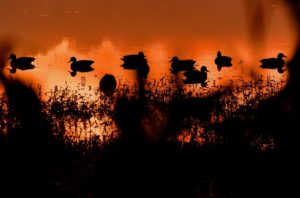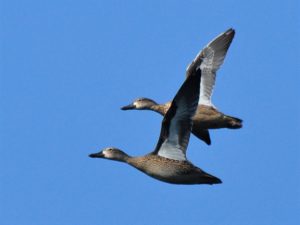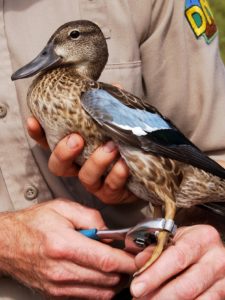Photography courtesy of Lowell Washburn, all rights reserved.
Iowa’s fifth annual, Teal-Only Duck Hunting Season is underway. The early hunt began September 1 and runs through September 16. Shooting hours are from sunrise to sunset each day. Only teal are legal game during the special season; the daily bag limit is six blue-winged or green-winged teal. The 16-day hunt is timed to coincide with peak migrations of blue-winged teal – one of the continent’s most abundant but least utilized waterfowl. Iowa’s teal season is offered to hunters as a free bonus and does not subtract from the state’s regular 60-day duck season.
Here today, gone tomorrow; blue-winged teal are the first waterfowl species to depart the northern breeding grounds each fall. Moving hard and fast down the flyways, blue-wings live trapped, banded, and released at Winnebago County’s Rice Lake have been recovered within weeks by hunters from as far away as Jamaica and Guatemala. The majority of blue-winged teal will have passed to the south of Iowa, and other northern states, by mid-September; well in advance of traditional duck openers.
A plentiful inhabitant of shallow marshlands, early season blue-wings have a lot to offer. They are readily accessible to hunters of all ages and all levels of expertise. You don’t need expensive blind boats, motors, or tons of specialized equipment to enjoy teal hunting success. A pair of rubber boots, light bag of decoys, and pocket full of shotgun shells are all you need. On second thought, better make that two pockets full of shells.
 Although blue-winged teal are low level fliers and readily come to decoys; they generally do so at break neck speeds. While getting flocks to come close is easy, putting those birds in the bag becomes an entirely different matter. Most hunters miss far more blue-wings than they manage to hit. As delicious as they are fast, those teal that are brought to bag provide nothing short of five-star dining.
Although blue-winged teal are low level fliers and readily come to decoys; they generally do so at break neck speeds. While getting flocks to come close is easy, putting those birds in the bag becomes an entirely different matter. Most hunters miss far more blue-wings than they manage to hit. As delicious as they are fast, those teal that are brought to bag provide nothing short of five-star dining.
Early season, warm weather teal hunts are nothing new in Iowa. A news brief posted in an August 1896 edition of the Clear Lake Mirror Reporter noted that local hunter, John Berkley had gotten his season off to a roaring start by shooting 73 of the tasty ducks. The columnist added that during the previous week “a great many hunters” had visited Clear Lake and that the fowlers had been “fairly successful”.
Iowa’s first series of Special Teal Seasons occurred during the 1960s. The daily bag limit was four teal. In order to participate, you had to apply to the Federal Fish & Wildlife Service, Washington, D.C. for a special teal hunting permit. As a teen-age waterfowl enthusiast, I became a proud possessor of the above-mentioned permit. Of course, there were a lot more duck hunters during the 1960s, and expectations ran high. During the week leading up to the special hunt, our high school lunch room buzzed with excitement as clusters of outdoor minded students discussed plans for the upcoming season.
Back then, private farmlands still harbored an abundance of natural wetlands. Most farmsteads had a boggy pasture, cattail marsh or some sort of Back Forty duck pond. Obtaining permission to hunt those habitats was as easy as knocking on the front door. The teal were thick, and we generally encountered little difficulty in bagging a mess of fat blue-wings.
Although the 1960s Teal Seasons were extremely popular with Iowa hunters, the special hunts [while continuing in the Southern states] have been discontinued in the northern waterfowl production states – including Iowa – during the past several decades. Re-authorized for northern flyway states by the U.S. Fish & Wildlife Service in 2014, the reinstatement of the Iowa teal seasons has represented the best single change in waterfowl regulations in the past half century. There are no down sides to the bonus hunt. For Iowa waterfowlers, the special teal seasons are simply a win win win scenario; offering duck hunters the best of all worlds.
LW



 Tom Cope
Tom Cope Sue Wilkinson
Sue Wilkinson Susan Judkins Josten
Susan Judkins Josten Rudi Roeslein
Rudi Roeslein Elyssa McFarland
Elyssa McFarland Mark Langgin
Mark Langgin Adam Janke
Adam Janke Joe Henry
Joe Henry Kristin Ashenbrenner
Kristin Ashenbrenner Joe Wilkinson
Joe Wilkinson Dr. Tammy Mildenstein
Dr. Tammy Mildenstein Sean McMahon
Sean McMahon